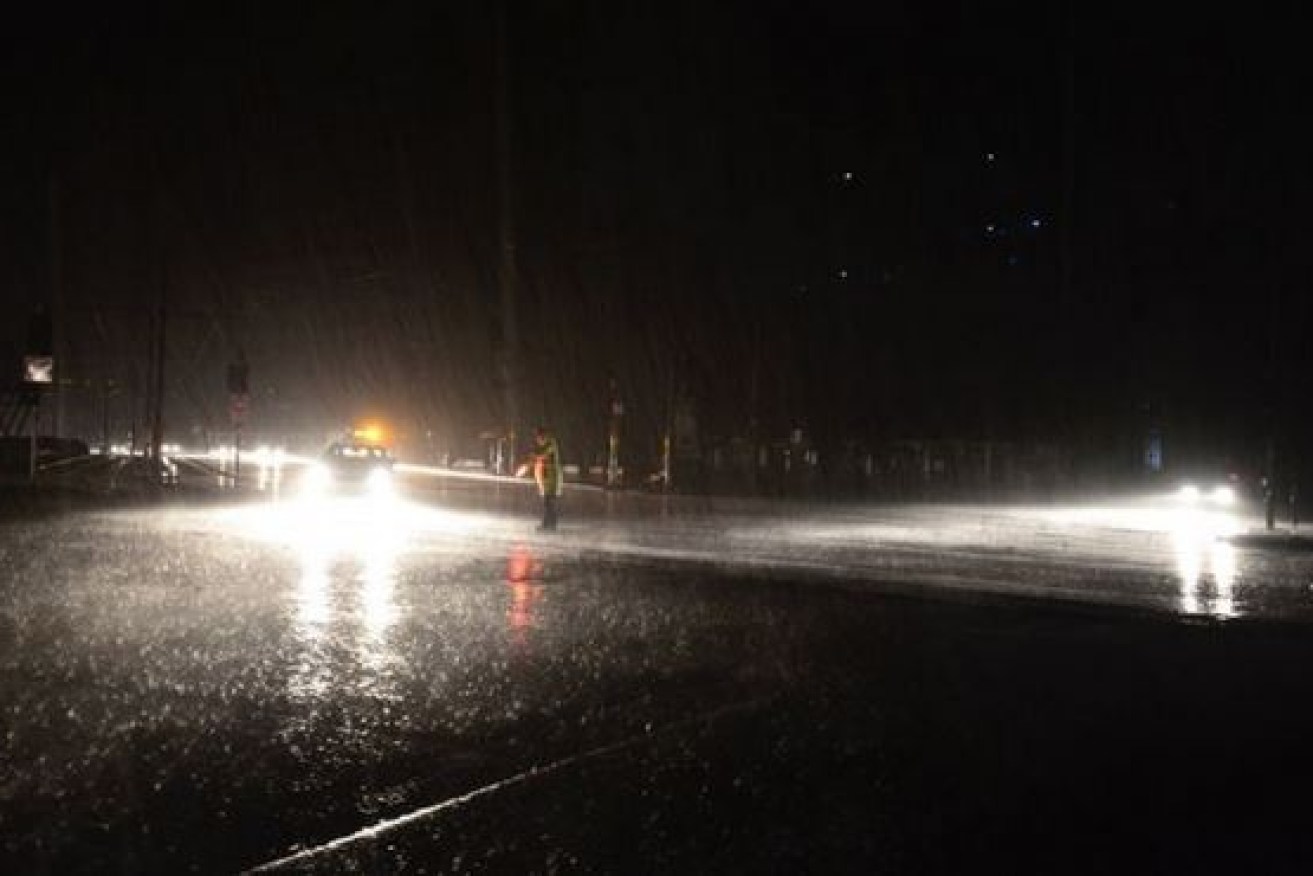Dark days looming for electricity and jobs: retailer

A lone policeman endures the dark and the driving rain to direct traffic with a flashlight during South Australia's September statewide blackout.September. Photo: ABC News, Tony Hill
The head of the Food and Grocery Council says manufacturers will quit Australia if affordable, reliable energy cannot be guaranteed, as concern grows about the cost of power and the stability of the electricity grid with Victoria’s Hazelwood power station due to close in a fortnight.
The ageing brown-coal-fired generator in the Latrobe Valley will begin the staged shutdown of its eight units from March 27, with the final boiler set to go cool on April 2.
With it will go 22 per cent of Victoria’s power supply and just over 5 per cent of the energy on a grid that runs from Port Douglas in far north Queensland to Port Lincoln on South Australia’s Eyre Peninsula.
The wholesale price of power spiked across the National Electricity Market in November on news that Hazelwood would shut.
Food and Grocery Council chair Terry O’Brien said his industry had been caught in a pincer movement, unable to pass on power price hikes because of discounting by the two major supermarkets chains.
As many local manufacturers were arms of international companies, pressure was mounting for some to quit the country.
“The decision to stay or go gets more and more marginal as the days go on,” Mr O’Brien said.
“And there’s not a heck of a lot of sentiment in these internationally managed companies. They go where it makes sense. And if it’s not going to make sense here, they leave.”
The closure of Hazelwood raises an even larger threat: blackouts.
“To stop production through a lack of energy is just a disaster,” Mr O’Brien said.
The threat of east coast blackouts is now real because of the disorganised disconnection of coal-fired generation without any new investment in base-load power.
Hazelwood will be the ninth power plant to close in five years, removing a combined 5,400 megawatt hours of generation from the grid. The Australian Energy Market Operator is now predicting electricity reserve shortfalls in Victoria and South Australia from December.
Australian Energy Council chief executive Matthew Warren said that did not guarantee the lights would go out but the extra pressure applied to an ageing fleet of generators left “a very fragile setup”.
“If anything goes wrong, if an interconnector fails or is switched off, if generating units can’t meet their maximum output, we start risking blackouts,” Mr Warren said.
Hazelwood unit controller Mark Richards said all the generator’s eight units had been running “pretty much continuously” throughout the last summer and the grid still struggled to meet peak demand. Victoria had traditionally been an energy exporter and its base-load power stabilised South Australia’s wind-dependent grid.
“The real issue will be next summer,” Mr Richards said.
“There’s already projections from [the market operator] showing that there’s going to be shortfalls. And that’s combined with the problems of gas price increases.”
The lack of gas for domestic generators is just another front in the perfect storm of Australia’s energy crisis. The nation’s abundant gas reserves are mostly tied up in export contracts.
The Prime Minister called gas producers to Canberra last week and threatened market intervention unless they made gas available for domestic demand. He won a promise, not a guarantee, and the gas price is likely to be high.
Mr Richards said intermittent renewable energy could not be relied on during days of peak demand.
“The renewables energy market is essentially propped up by gas”, Mr Richards said.
Most of Australia’s investment in new generation has been in wind farms, driven by the Commonwealth’s Renewable Energy Target. And the lion’s share of the investment landed in South Australia, which, at over 40 per cent of generation, now has one of the highest penetrations of renewable energy in the world.
Once wind energy passes about 20 per cent of generation it creates a series of well-documented challenges for electricity grids in both managing intermittency and stabilising the system’s frequency.
After a series of blackouts since September, the Weatherill Government dramatically intervened in the market last week to prop up its grid with a $360 million investment in a new state-owned 250MWh gas-fired power plant and a $150 million bid for battery storage.
If all else fails the state is also buying 250MWh of diesel generators to try to keep the lights on this summer.
The problems with South Australia’s grid were predicted by the man who closed Northern, the last coal-fired power plant in the state.
Alinta Energy chief executive Jeff Dimery said that wind had an important role to play in helping to decarbonise generation but it was “an unreliable, or an intermittent form of energy supply”.
“So absent massive amounts of storage in the market — so that you can store up that energy when it’s produced and release it when it is demanded from consumers — we have a problem,” Mr Dimery said.
“That leads to expensive fixes.”
Battery technology was advancing rapidly and the cost was falling but it was still not an economic solution for Australia. What made sense for households did not, yet, add up for business.
Mr Dimery said the investment strike on building new gas generation would not end until the political brawl over energy policy did.
The starting point should be a national, bi-partisan commitment to a price on carbon to provide certainty for investors.
– ABC








